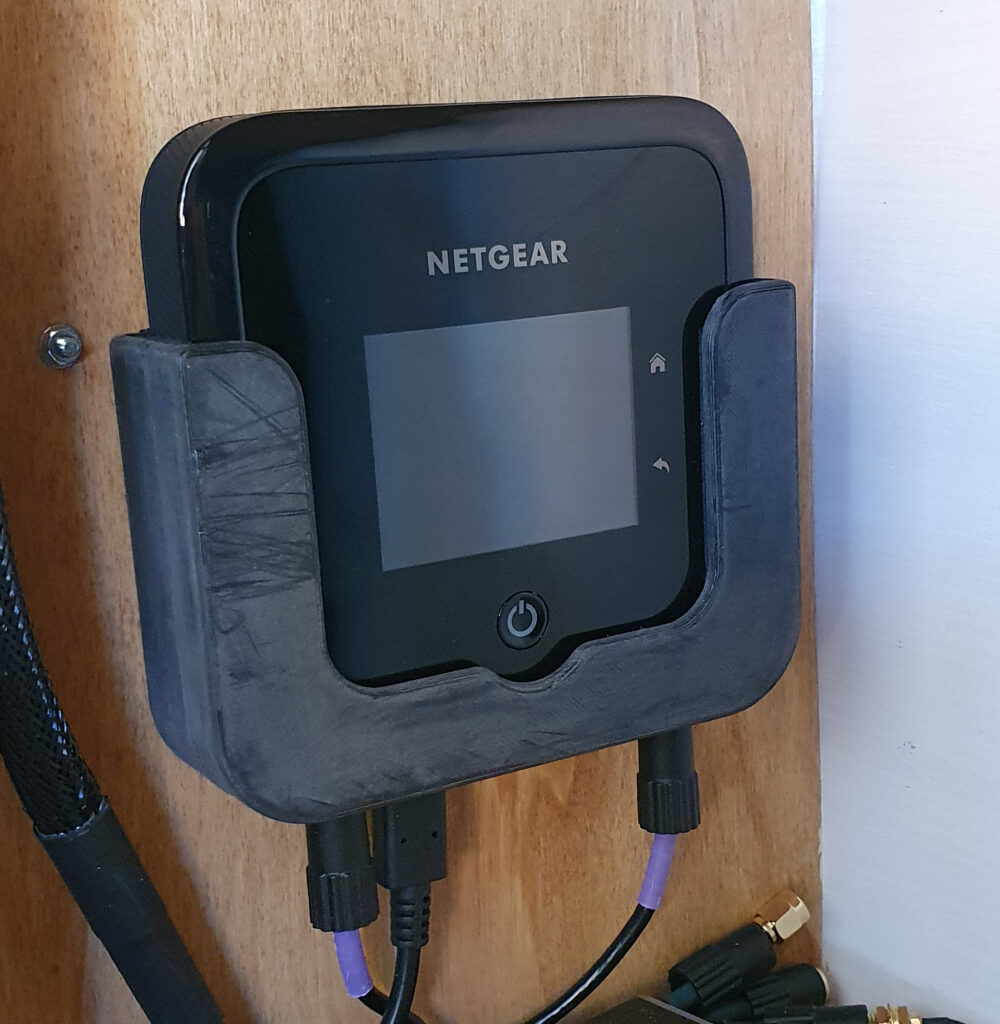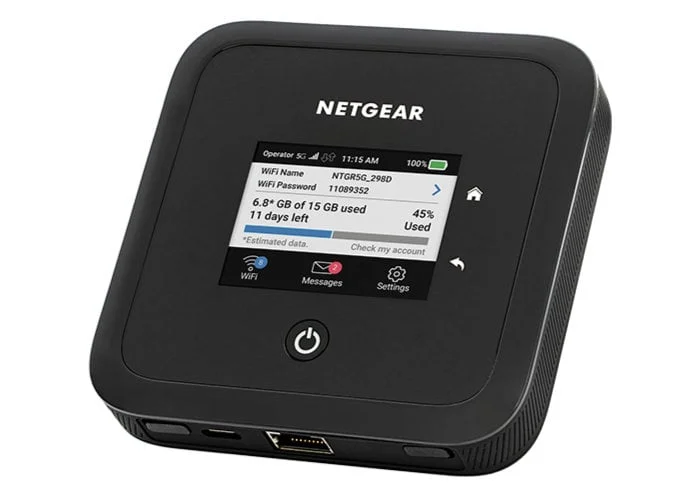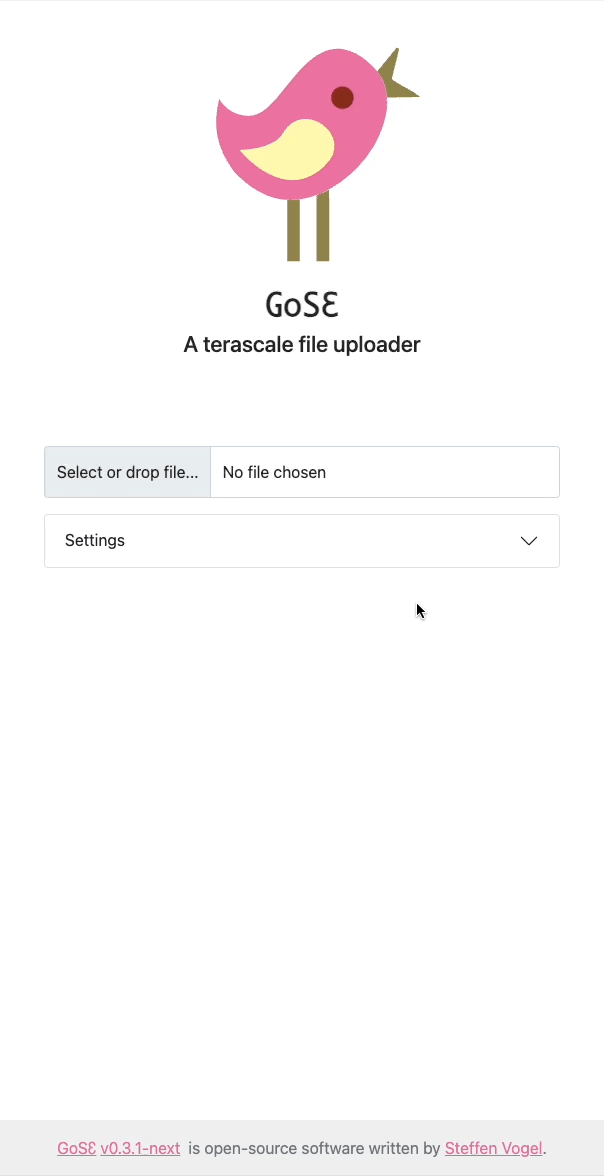After gaining root access to the device in the first post of this series, we will have a closer look at the device and its firmware.
This post is documenting some internals of the device which is not the most exciting stuff to read. I mainly collected it here for documentation purposes.
All information in this post has been collected from a device running firmware version NTGX55_12.04.12.00.
Software
Netgear’s firmware is Linux-based and uses quite a lot of common open-source tools. They provide all modifications to GPL licensed code via their support area: NETGEAR Open Source Software for Programmers.
From what I can tell only their user interface and configuration management is developed by Netgear themself apart from a bunch of binary blobs provided by Qualcomm which contains the modem firmware which gets loaded to the baseband processor.
One curiosity catched my eye: there is a running X server on the device. It is used by the front-panel display of the device. A custom application developed by Netgear uses Webkit’s engine to render the touch screen interface which just like the web UI is based on HTML and Javascript.
Here is an almost complete list of open source software components which I found on the device:
- atk (v2.28)
- Avahi (v0.7)
- bash (v4.4.23)
- base-files (v3.0.14)
- BusyBox (v1.29.3)
- conntrack-tools (v1.0.1)
- D-Bus (v1.12.10)
- ddclient (v3.8.1)
- dhcpcd (v5.2.10)
- DiG (v9.11.5-P4)
- Dnsmasq (v2.85)
- ethtool (v4.19)
- font-config (v2.12.6)
- freetype (v2.9.1)
- glib (v2.58.0)
- hostapd (v2.8-devel)
- iproute2 (iproute2-ss140804)
- iptables (v1.6.2)
- iw (v4.14)
- libcap (v2.25)
- libnfnetlink (v1.0.0)
- Linux Kernel (v4.14.117)
- miniupnpd
- mtd-utils (v2.0.2)
- nettle (v3.4)
- OpenSSL (v1.1.1b)
- pimd (v2.1.8)
- pppd (v2.4.7)
- strace (v4.24)
- SystemD (v239)
- tinyproxy (v1.8.3)
- util-linux (v2.32.1)
- wireless-tools (v30)
- wpa_supplicant (v2.9)
- Xorg (v1.20.1)
- xz (v5.2.4)
Basic facts
Lets first have a look at the Kernel version:
$ uname -a Linux sdxprairie 4.14.117 #1 PREEMPT Thu Aug 19 23:42:26 UTC 2021 armv7l GNU/Linux / # cat /proc/version Linux version 4.14.117 (oe-user@oe-host) (clang version 6.0.9 for Android NDK) #1 PREEMPT Thu Aug 19 23:42:26 UTC 2021
Apparently the firmware has been built by Open Embedded as indicated by the kernel notice „oe-user„.
There is also a /target file lying around. I assume that „sdxprairie“ is Qualcomm’s name for the SDK/BSP which is used by Netgear.
$ cat /target sdxprairie
The application processor of the Snapdragon X55 is a fairly low powered single-core ARM v7:
$ cat /proc/cpuinfo processor : 0 model name : ARMv7 Processor rev 5 (v7l) BogoMIPS : 38.40 Features : half thumb fastmult vfp edsp neon vfpv3 tls vfpv4 idiva idivt vfpd32 lpae evtstrm CPU implementer : 0x41 CPU architecture: 7 CPU variant : 0x0 CPU part : 0xc07 CPU revision : 5 Hardware : Qualcomm Technologies, Inc SDXPRAIRIE Revision : 0000 Serial : 0000000000000000
With around 780 MB of RAM:
$ free -m
total used free shared buffers cached
Mem: 781 387 393 0 0 142
-/+ buffers/cache: 245 535
Swap: 109 0 109
SoC details
Within the SysFS we can find some details about the SoC. More details about the meaning can be found in the Kernel documentation:
| SysFS Entry | Value |
| /sys/devices/soc0/accessory_chip | 0 |
| /sys/devices/soc0/chip_family | 0x5e |
| /sys/devices/soc0/chip_name | SDX55 |
| /sys/devices/soc0/family | Snapdragon |
| /sys/devices/soc0/foundry_id | 1 |
| /sys/devices/soc0/hw_platform | MTP |
| /sys/devices/soc0/image_crm_version | :ntgrbc-fwbuild6 |
| /sys/devices/soc0/image_variant | MAATANAZA |
| /sys/devices/soc0/image_version | 00:BOOT.SBL.4.1-00231 |
| /sys/devices/soc0/machine | SDXPRAIRIE |
| /sys/devices/soc0/ncluster_array_offset | 0xb0 |
| /sys/devices/soc0/ndefective_parts_array_offset | 0xb4 |
| /sys/devices/soc0/nmodem_supported | 0xffffffff |
| /sys/devices/soc0/nproduct_id | 0x410 |
| /sys/devices/soc0/num_clusters | 0x1 |
| /sys/devices/soc0/num_defective_parts | 0xd |
| /sys/devices/soc0/platform_subtype | Invalid |
| /sys/devices/soc0/platform_subtype_id | 5 |
| /sys/devices/soc0/platform_version | 65536 |
| /sys/devices/soc0/pmic_die_revision | 131072 |
| /sys/devices/soc0/pmic_model | 65568 |
| /sys/devices/soc0/raw_device_family | 0x6 |
| /sys/devices/soc0/raw_device_number | 0xb |
| /sys/devices/soc0/raw_id | 207 |
| /sys/devices/soc0/raw_version | 2 |
| /sys/devices/soc0/revision | 2.0 |
| /sys/devices/soc0/select_image | 0 |
| /sys/devices/soc0/serial_number | 27453XXXX |
| /sys/devices/soc0/soc_id | 357 |
| /sys/devices/soc0/vendor | Qualcomm |
$ cat /sys/devices/soc0/images
0:
CRM: 00:BOOT.SBL.4.1-00231
Variant: MAATANAZA
Version: :ntgrbc-fwbuild6
1:
CRM: 01:TZ.FU.5.9-00147
Variant: EATAANBAA
Version: :CRM
11:
CRM: 11:MPSS.HI.2.0.c3.5-00010-SDX55_CPEALL_PACK-1.403198.3
Variant: sdx55.gennatch.prod
Version: :ntgrbc-fwbuild6
Kernel command line
$ cat /proc/cmdline<br>noinitrd rw rootwait console=ttyMSM0,115200,n8 androidboot.hardware=qcom msm_rtb.filter=0x237 androidboot.console=ttyMSM0 lpm_levels.sleep_disabled=1 firmware_class.path=/lib/firmware/updates service_locator.enable=1 net.ifnames=0 atlantic_fwd.rx_ring_size=1024 pci=pcie_bus_perf rootfstype=ubifs rootflags=bulk_read root=ubi0:rootfs ubi.mtd=24 androidboot.serialno=105d0dc7 androidboot.baseband=msm
Kernel log
Unfortunately, I was not able to capture early kernel log messages. I assume those are only printed via a serial port and lost as the circular buffer for the kernel log has not been set up.
- Full log: dmesg.txt
More details…
- Network interfaces: interfaces.txt (ip address show)
- Devices: devices.txt (ls -l /dev)
- Kernel modules: modules.txt (lsmod)
- Running processes: processes.txt (ps aux)
- Mounted filesystems: mounts.txt (mount)
- Flash partitions: mtd.txt (cat /proc/mtd)
- Open ports: ports.txt (netstat -plnt)
- Ubi devices & volumes: ubinfo.txt (ubinfo -a)
- Kernel config: config.txt (zcat /proc/config.gz)
- Devicetree source: device-tree.dts (dtc -I fs -O dts /proc/device-tree)
Feel free to contact me if I missed any particular detail which is interesting for you.









